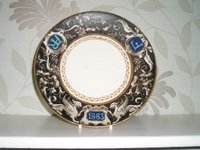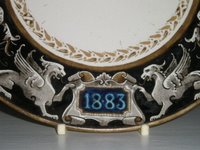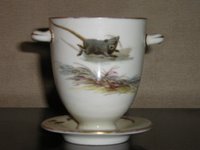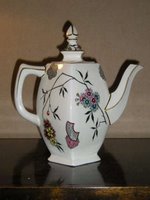 So, here is my collection of Powell, Bishop & Stonier (P.B&S) in the Oriental Ivory range with the chinaman+parasol backstamp. It's interesting to note the variety of patterns, from very obvious oriental inspired designs, to very un-oriental ones which simply used the ivory body.
So, here is my collection of Powell, Bishop & Stonier (P.B&S) in the Oriental Ivory range with the chinaman+parasol backstamp. It's interesting to note the variety of patterns, from very obvious oriental inspired designs, to very un-oriental ones which simply used the ivory body.
Thursday, August 10, 2006
Oriental Ivory
 So, here is my collection of Powell, Bishop & Stonier (P.B&S) in the Oriental Ivory range with the chinaman+parasol backstamp. It's interesting to note the variety of patterns, from very obvious oriental inspired designs, to very un-oriental ones which simply used the ivory body.
So, here is my collection of Powell, Bishop & Stonier (P.B&S) in the Oriental Ivory range with the chinaman+parasol backstamp. It's interesting to note the variety of patterns, from very obvious oriental inspired designs, to very un-oriental ones which simply used the ivory body.
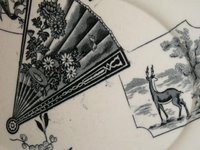
Some shapes were used over and over again with different patterns sometimes completely ignoring other design elements of the piece such as moulded reliefs- best illutrated by my Miako pattern platter which overlays a printed design on a rather more sugary ribbon and rope moulded relief.
The oriental inspired designs were very often very stylized to fit the fashionable Aesthetic Movement look, with motifs like fans, chinese wheels, freizes and picturesque landscapes. Other pieces used a botanical idea for a more traditional English look, such as this jug. Interestingly, the shape of the jug hints at a move towards more Art Deco geometric body shapes.
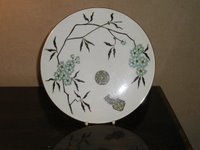 I have two tazzas with eagle claw moulded trefoil bases. They have two very different designs:
'Mikado' , an oriental inspired aesthetic design and a hand-painted armourial design (probably a special commission) with heraldic beasts, intials (AR & F) and a date of 1883.
It also has a latin phrase,"Virtue non armis fido".
If anyone can tell me what this means, i'd be very grateful! I have also seen the same body shape with a nursery rhyme theme (these were commonly produced in 1920s/30s and mostly on childrens teasets and beakers etc).
I have two tazzas with eagle claw moulded trefoil bases. They have two very different designs:
'Mikado' , an oriental inspired aesthetic design and a hand-painted armourial design (probably a special commission) with heraldic beasts, intials (AR & F) and a date of 1883.
It also has a latin phrase,"Virtue non armis fido".
If anyone can tell me what this means, i'd be very grateful! I have also seen the same body shape with a nursery rhyme theme (these were commonly produced in 1920s/30s and mostly on childrens teasets and beakers etc).
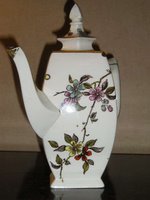
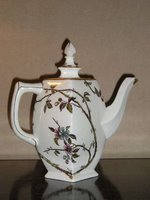

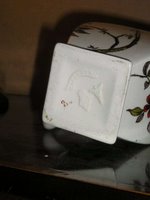 Other pieces in my collection that follow on from the oriental ivory look are two coffeepots which have gorgeous foliage and oriental motifs. The two printed designs are similar and use the same body shape - a cuboid shaped pot.
Curiously, it was some time before George Clews patented his Cube teapot that was widely used by Cunard on cruise ships during the Art Deco period. P.B&S were ahead of their time!
Other pieces in my collection that follow on from the oriental ivory look are two coffeepots which have gorgeous foliage and oriental motifs. The two printed designs are similar and use the same body shape - a cuboid shaped pot.
Curiously, it was some time before George Clews patented his Cube teapot that was widely used by Cunard on cruise ships during the Art Deco period. P.B&S were ahead of their time!

 Another unusually shaped object is this octagonal coffee cup and saucer - I believe it to be for coffee because of it's dainty size. The printed pattern is Japanese inspired with Cranes, water lillies and accanthas leaves. The taste for Japonism was everywhere in the 1890s from Pottery to wallpaper and furniture. Britains were beginning to explore the far east as tourists, just as they had done in Europe in the 18th and early 19th century on the "Grand Tour".
Another unusually shaped object is this octagonal coffee cup and saucer - I believe it to be for coffee because of it's dainty size. The printed pattern is Japanese inspired with Cranes, water lillies and accanthas leaves. The taste for Japonism was everywhere in the 1890s from Pottery to wallpaper and furniture. Britains were beginning to explore the far east as tourists, just as they had done in Europe in the 18th and early 19th century on the "Grand Tour".
Wednesday, August 09, 2006
bisto barmey
Well, I guess you may have ended up here by mistake. Disappointed? Funny how a search for internet pornography can go so wrong. But also strangely pleasing to me that your desire to "get off" brought you here as that is exactly my point about pottery. Perhaps you're pleasantly surprised however, as you too share a fetish for all things ceramic and love to caress pots like a ripe bottom or ogle makers marks like a cute birth mark on the back of a loved-one's knee.
As you will have realised by now, there are no naked ladies or lithe lads to be found on these pages, just lots of gorgeous glazes, lovely lustres, erogenous enamels and curvaceous bodies. Under 18s, you can stay, but if you are of a weak disposition when it comes to vases and teapots...better leave now.
If you got here by mistake because you were looking for gravy related pages... you sicko!!! get outta here you freak!!!!!
I can't really say when my love of ceramics began, but I guess I've always been a fan of nick-nacks and ornaments etc. Although my family has never been the sort to line every shelf, mantle, and window sill with hideous figurines or gaudy Whitefriars vases. Growing up, there were always a few trinkets that crept into our domestic scenery: a black labrador puppy that stared with orange glazed eyes, a ghastly post-war japanese lithopane teaset that my dad inheritted, a set of crystal glasses that were accumulated from Texaco garages in reward for buying their petrol...all tat, but all firmly etched in my memory of my childhood and helping to form my love of "things".
I was so glad when the 90's ended, not least because it drew to a close my teenage years and a time of torment when I was coming out and "finding myself". But also because the 90's was all about minimalism and the decluttering of our lives and the rejection of "things". It seemed that everyone was after space and blandness. How boring! But the years since have thankfully seen a return of clutter; crappy things to buy and fill up your life with (if you've got a life). Perhaps we're going too far now and heading for a repeat of the 1980's excess story, but it can't be as bad as the fascistic minimalism of the 90s. I'm more of an 1890s man.
What's the point of this blog you're asking. Well, it's going to be pretty simple really. My intention is to post a few thoughts and findings about my own ceramic collection, illustrated with a few pics, and to invite your comments, suggestions and information to help build my knowledge (which is woefully lacking in some areas and mainly gleaned from TV progs like Flog-it and Antiques Roadshow). If you have a similar interest, I'd love to hear from you.
I originally started a collection of English Polychrome enamel chinoiserie porcelain; with makers such as Hilditch, New Hall, Rathbone, Machin. I had found a teacup and saucer in my local Oxfam shop, marked at £1.50 - a bargain I thought! And indeed it was for after some research, I discovered it was a pattern known as "lady with lyre" by Hilditch and probably worth something closer to £25. The boyfriend (callumjames.blogspot.com), delighted that I had finally found a geeky interest in something and now with a desire to "collect" (he's autistically OCD about collecting books) bought me a copy of 'Chinoiserie: Polychrome Decoration on Staffordshire Porcelain 1790-1850' by Howard Davis. A fascinating book with lots of detail about how the trend for Chinoiserie design in ceramics developed, changed and declined; also with lots of great illustrative photos - a MUST book for any collector of this type of pottery+porcelain.
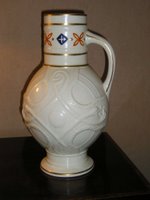 Not long after my first introduction to antique china, in the same Oxfam shop, I came across a large ivory coloured jug, for £10, with an amazing celtic cross design (made up of entwined serpents/dragons/sea creatures - not sure what they are!). I wondered if it might be classed as 'majolica' but settled on it just being 'moulded'. Is there a difference??? I had also recently bought a Miller's guide to Ceramics and was leafing through one evening when I saw a picture of my jug! Although the colouration was slightly different, it was definitely the same kind of jug and was priced at a healthy £70-80. The book had it listed as by a Staffordshire potter, but gave no further details. After lots of close inspection on the very faint makers mark on the bottom of the piece, I found it to be a Wand of Caduceus mark, employed by Powell & Bishop and later Powell, Bishop & Stonier in the late 1870s onwards. The ivory body colour of the jug was a precursor of P.B&S's "Oriental Ivory" range that cashed in on the Victorian's love of all things
Not long after my first introduction to antique china, in the same Oxfam shop, I came across a large ivory coloured jug, for £10, with an amazing celtic cross design (made up of entwined serpents/dragons/sea creatures - not sure what they are!). I wondered if it might be classed as 'majolica' but settled on it just being 'moulded'. Is there a difference??? I had also recently bought a Miller's guide to Ceramics and was leafing through one evening when I saw a picture of my jug! Although the colouration was slightly different, it was definitely the same kind of jug and was priced at a healthy £70-80. The book had it listed as by a Staffordshire potter, but gave no further details. After lots of close inspection on the very faint makers mark on the bottom of the piece, I found it to be a Wand of Caduceus mark, employed by Powell & Bishop and later Powell, Bishop & Stonier in the late 1870s onwards. The ivory body colour of the jug was a precursor of P.B&S's "Oriental Ivory" range that cashed in on the Victorian's love of all things 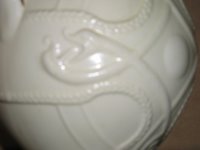 Oriental and the aesthetic movement's fascination with Japonism. The company used another mark for this particular range, a chinaman sitting under a parasol; very distinctive and rather cute. I love makers marks.
Oriental and the aesthetic movement's fascination with Japonism. The company used another mark for this particular range, a chinaman sitting under a parasol; very distinctive and rather cute. I love makers marks. Once I had found out a little about the history of the Powell, Bishop & Stonier (what little info there is on the internet), I looked around for other pieces. Surprisingly, there isn't a lot to be had, unlike the wealthy dirge of pieces by Wedgwood, Carltonware, Meakin, Johnson Bros etc. Admittedly, my budget is mainly restricted to Charity shops and Ebay, so I may be misrepresenting how common/rare P.B&S pieces are, but it seems to me that not a lot of their more interesting stuff has survived, or at least, comes on the market. There is more of the prozaic, mundane tableware around, just as there is for most victorian earthenware manufacturers, but larger, more decorative pieces are harder to come by. Perhaps this is a reflection of changing tastes as their orientalist work is very out of fashion nowadays and may have found it's way on to scrap-heaps.
Powell, Bishop & Stonier, became Bishop & Stonier when Edwin Powell retired. And B&S used these new initials as their mark along with the more recognisable 'BISTO' - a joining of their two names. In the 1930s, there was a brief period when the company became 'BISHOPS' before it was taken over by the George Jones factory. The BISTO company continued to produce the Oriental Ivory range for a time, but changing tastes at the start of the 20th century meant that they changed direction to produce more Art Nouveau and then Art Deco designs. The shapes and patterns they used were very commercial for the time and were retailed by company's like Harrods.
OK, I'm going on a bit now and forgive me if any of the info given so far is incorrect; as mentioned, all of it has been found on the internet and may be wrong. The best site I have found for this kind of thing is www.thepotteries.org so maybe you should check it out yourself.
Time to go for now I think because even if you're not bored yet, i'm getting there. Not by PB&S of course, but by trying to be entertaining and witty about it all. Surprisingly, intelligent and witty comments don't come that easily when I think about ceramics. I think it's must be more of an aesthetic thing and I'll leave the humour to someone else. Anyone got any pot jokes?
Subscribe to:
Posts (Atom)
About Me

- The Ticcy Knitter
- Sometimes, life doesn't turn out the way you expected. And sometimes, it is exactly as it was 'meant' to be. I believe that life is a both a learning experience and an obstacle course to be climbed and clambered over in the most creative way possible! In doing so, you'll get to where you should be even if it's not where you'd imagined.


